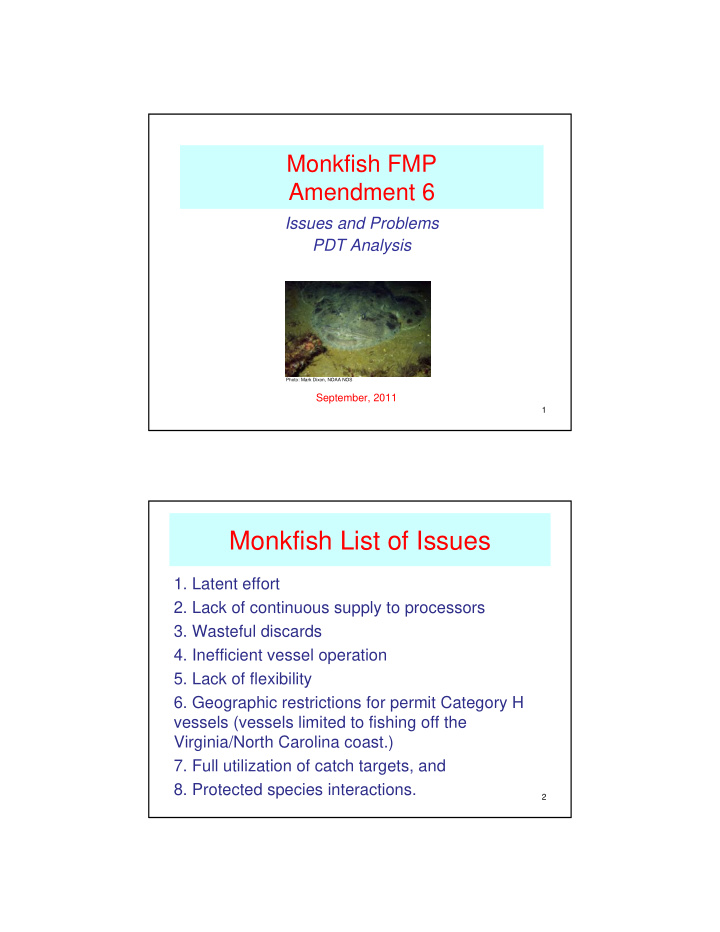



Monkfish FMP Amendment 6 Issues and Problems PDT Analysis Photo: Mark Dixon, NOAA NOS September, 2011 1 Monkfish List of Issues 1. Latent effort 2. Lack of continuous supply to processors 3. Wasteful discards 4. Inefficient vessel operation 5. Lack of flexibility 6. Geographic restrictions for permit Category H vessels (vessels limited to fishing off the Virginia/North Carolina coast.) 7. Full utilization of catch targets, and 8. Protected species interactions. 2
PDT and AP Tasking • June 1 OS meeting, Committee tasked PDT to develop problem statements based on analysis of the bullet list of issues • June 8 th conference call, PDT determined it could provide analysis or discussion of Latent Effort (#1), Processor Supply (#2), Discards (#3) and Cat. H vessels (#6). Other issues required additional input from advisors or committee. • Timing of PDT work a question due to other commitments by some members. • AP met July 19 to provide further input and details on the issues and problems 3 Latent Effort • PDT evaluated effort patterns for FY2007-2010 • For this analysis, latent effort is defined as allocated but unused DAS • The current method of allocating DAS is based on DAS used by active vessels, although DAS are allocated to all vessels. For this reason, if latent effort becomes active (vessels that have not used their DAS, begin to do so), there is a risk that catch will exceed the target in the short term. That activated effort, however, would be considered in any future specifications process 4
Latent Effort • Fairly consistent DAS usage rates during the period, even with 2010 sector adoption in the groundfish fishery, i.e., latent effort has not been activated • ~50% of allocated effort has a low probability of being used because: a) scallop vessels do no want to use a scallop DAS to target monkfish; b) some vessels have no landings of any species and are inactive; and, c) some vessels only fish in the SMA despite being allocated NMA DAS. • Of the remaining allocated DAS, 19% of the total is allocated to vessels that fished for other species and did not use a MF DAS; the remaining 31% is allocated to vessels that used at least one MF DAS, but almost half of those DAS are unused. This latter group (14% of the total DAS allocation) is the one with the greatest potential for short term activation, since those vessels already target monkfish. 5 2010 Used and Unused DAS 6
Category H Permit Issues • Established in Amendment 2 ; 7 total permits, only 6 active • Limited to fishing below 38º40’ N Lat and constrained by turtle closures and harbor porpoise restrictions • Monkfish season limited to April – June • Vessels as a group use ~50% of allocated DAS 7 Category H Fishery Map 8
Category H Monthly Landings 9 Other Issues • PDT is in process of discards analysis: monkfish and other species in the monkfish fishery (on a DAS), and monkfish in other fisheries (not on a MF DAS); not yet completed • Conducting processor telephone survey to substantiate processor supply issue, also not yet completed 10
Committee Decisions 8/31 • A6 goals and objectives be based on the list of issues as they relate to the northern and southern management areas • PDT to summarize work that has been done to date to characterize the significance and importance of each issues on the list for the NMA and SMA • Request that NMFS calculate individual contribution factor based on landings history for three time periods (see motion) 11 What’s next? • Final recommendations on Amendment 6 goals and objectives • Increased coordination with the MAFMC, including additional OS seats and meetings in the Mid- Atlantic area. 12
Recommend
More recommend